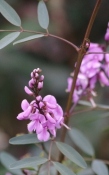 End of Winter and early Spring is a time for Wattles! Lots of Wattles!
End of Winter and early Spring is a time for Wattles! Lots of Wattles!
It’s a great time to learn some new plant ID skills. Acacias are very easily identifyable when in flower, which makes them a great place to start if you want to learn some botany.
If you are in Victoria, the book “Native Trees and Shrubs of South-Eastern Australia” by Leon Costermans has a great key for this genus.
It is also a great time to see Hardenbergias – our “native wisterias”. This is an amazingly ornamental plant and if you have a fence or trellice you should give them a go as they are easily available from Garden Centres (although we recommend a specialist indigenous nursery as these will draw from the gene pool of your local area).
Also in flower is Pimelea humilis (Common Rice Flower), Drosera peltata (Pale Sundew), Chrisocephalum apiculatum (Common Everlasting), Wurmbea dioica (Common Early Nancy) and if you are really lucky, you might even find a Pterostylis sp (Greenhood Orchid)!
In the next couple of months, many more plants will start to flower. October and November are the best time of the year to see wildflowers, so charge up your camera and get out there! 






